 On March 3, the Senate confirmed Linda McMahon as the thirteenth secretary of education.1 Secretary McMahon has pledged to dismantle the Department of Education in what she calls its “final mission,” and on March 11, the Department announced it was cutting nearly 50 percent of its workforce.2 President Donald Trump is expected to sign an executive order directing Secretary McMahon to “take all necessary steps to facilitate the closure of the Education Department,” though the Department cannot be abolished unilaterally by the executive branch; this would require an act of Congress.3
On March 3, the Senate confirmed Linda McMahon as the thirteenth secretary of education.1 Secretary McMahon has pledged to dismantle the Department of Education in what she calls its “final mission,” and on March 11, the Department announced it was cutting nearly 50 percent of its workforce.2 President Donald Trump is expected to sign an executive order directing Secretary McMahon to “take all necessary steps to facilitate the closure of the Education Department,” though the Department cannot be abolished unilaterally by the executive branch; this would require an act of Congress.3
What Is the Department of Education?
The Department of Education that we have today was created by Congress in 1979 as a cabinet-level department within the executive branch of the federal government.4 It consolidated resources, staff, and programs across other executive departments and agencies into one centralized place in an effort to advance its goals of student success and opportunity in education.5 It is the smallest of the 15 cabinet departments, with approximately 4,200 employees.6 However, its budget is the third largest, after the Department of Defense and the Department of Health and Human Services.7
While the Department of Education is relatively modern and education in the United States is primarily a responsibility of state and local governments, the federal government has played a significant role in education policy since the 1860s. After the Civil War, it began collecting data and offering grants to aid states in creating schools, training teachers, and covering the cost of tuition for students.8 It funded school districts and provided loans for higher education during the post-World War II education boom and Cold War-era focus on the fields of science, technology, engineering, and mathematics.9 And during the civil rights era, it enforced equal protections in schools for students and teachers regardless of their race, color, national origin, sex, religion, age, or disability.10
In 2020-2021, approximately 11 percent of elementary and secondary public school funding was from federal sources, 46 percent was from state sources, and 44 percent was from local sources. With an annual budget of $268 billion, the Department of Education still primarily focuses on funding and research. It administers grants for schools and students, issues loans to students, collects and publishes data, recommends best practices, and ultimately ensures equal access to education for students across the country.11 Sixty percent of its funding goes directly to financial aid programs to help low-income students afford higher education.12 The Department of Education does not establish schools, set education standards, set graduation requirements, or create curricula.13
Why Is the Trump Administration Trying to Abolish the Department of Education?
There have been longstanding calls from the Republican Party to abolish the Department of Education. Mere months after the Department was created, the 1980 Republican platform stated that the party “supports deregulation by the federal government of public education, and encourages the elimination of the federal Department of Education.”14 Republican presidents since Ronald Reagan have called for the federal government to be scaled back in size and scope, preferring issues such as education to be left solely to the states. Despite this, when put to Congress, efforts to abolish the Department of Education have been soundly defeated across party lines in both the House of Representatives and the Senate.15
Secretary McMahon argues that the country does not need the Department of Education, and President Trump has routinely criticized it as unnecessary, wasteful, and ideologically compromised.16 In President Trump’s first term, his secretary of education took steps to curtail the work of the Department by shrinking the size of its workforce, reducing its budget, scaling back nondiscrimination protections, and rescinding guidance tied to the use of federal funds.17 In the first weeks of his second term, President Trump signed an executive order to deny funding for schools that he claims promote “radical, anti-American ideologies” that “deliberately [block] parental oversight.”18 And last month, the Department of Government Efficiency cut over $900 million in research contracts from the Department.19
What Do Supporters and Opponents Say?
President Trump’s criticisms of the Department of Education reflect the larger views of those who also support its abolition and are distrustful of the federal government, especially in the wake of the COVID-19 lockdowns, mask mandates, and the prevalence of diversity, equity, and inclusion initiatives.20 These supporters advocate for more power to states, school boards, and especially parents to make educational choices for their students, rather than relying on a bureaucracy in Washington. They advocate for school choice programs and funding for private schools, along with parental review of school curricula and book bans on local and state levels. Additionally, they cite the Department’s large budget and stagnant student test scores as further proof that it is ineffective at achieving its goals.21
Those who oppose abolishing the Department of Education reiterate that it is not involved in setting school standards or creating curricula. Instead, they underscore the importance of the Department’s role in providing funds and enforcing antidiscrimination laws. Pell Grants administered by the Department support one-third of low-income college students, and half of all undergraduates in the United States rely on some form of federal financial aid.22 Antidiscrimination laws make sure students have equal access and opportunity to succeed without burden or bias. With inequities growing between wealthier and poorer school districts and students, they see the Department of Education as vital, especially as students continue to struggle academically in the wake of the pandemic.23
Discussion Questions
- How would you rate the quality of your school and your education?
- How important of an issue is college affordability to you?
- What are the most persuasive reasons for abolishing the Department of Education?
- What are the most persuasive reasons against abolishing the Department of Education?
- Would you advocate for keeping or abolishing the Department of Education? Why?
- What role, if any, do you think the federal government should play in education policy?
Related Posts
- What Role Should Parents Have in Public Education?
- History and Civics Scores Drop in The Nation’s Report Card
As always, we encourage you to join the discussion with your comments or questions below.
Close Up is proud to be the nation’s leading nonprofit civic education organization, working with schools and districts across the country since 1971. If you would like to partner with us or learn more about our experiential learning programs, professional development, or curriculum design and consulting, contact us today!
Sources
Featured Image Credit: Alex Brandon/Associated Press
[1] U.S. Department of Education: https://www.ed.gov/about/news/press-release/us-senate-confirms-linda-mcmahon-13th-secretary-of-education-0
[2] Politico: https://www.politico.com/news/2025/03/04/linda-mcmahon-education-department-final-mission-00210057; CNN: https://www.cnn.com/2025/03/11/politics/department-of-education-cuts/index.html
[3] CNN: https://www.cnn.com/2025/03/06/politics/trump-education-department-shut-down-order/index.html
[4] U.S. Department of Education: https://www.ed.gov/about/ed-overview/mission-of-the-us-department-of-education
[5] U.S. Department of Education: https://www.ed.gov/about/ed-overview/federal-role-in-education
[6] New York Times: https://www.nytimes.com/2025/03/07/us/politics/education-department-mcmahon-trump.html
[7] U.S. Department of Education: https://www.ed.gov/about/ed-overview/federal-role-in-education
[8] Ibid.
[9] The Hechinger Report: https://hechingerreport.org/opinion-the-new-administration-could-be-on-the-verge-of-destroying-public-education-as-we-know-it/
[10] U.S. Department of Education: https://www.ed.gov/about/ed-overview/federal-role-in-education
[11] Yahoo News: https://www.yahoo.com/news/why-trump-wants-to-end-the-department-of-education–and-what-will-change-if-he-succeeds-214316185.html; National Center for Education Statistics: https://nces.ed.gov/programs/coe/indicator/cma/public-school-revenue
[12] Ibid.
[13] U.S. Department of Education: https://www.ed.gov/about/ed-overview/an-overview-of-the-us-department-of-education–pg-3
[14] The American Presidency Project: https://www.presidency.ucsb.edu/documents/republican-party-platform-1980
[15] New York Times: https://www.nytimes.com/2025/03/06/us/politics/trump-republicans-education-department.html
[16] New York Times: https://www.nytimes.com/2025/03/07/us/politics/education-department-mcmahon-trump.html
[17] Center for American Progress: https://www.americanprogress.org/article/trump-administrations-slow-steady-undoing-department-education/
[18] White House: https://www.whitehouse.gov/presidential-actions/2025/01/ending-radical-indoctrination-in-k-12-schooling/
[19] New York Times: https://www.nytimes.com/2025/02/11/us/politics/musk-doge-education-data.html?smid=url-share
[20] CNN: https://www.cnn.com/2024/02/03/us/moms-for-liberty-scandal-opposition/index.html
[21] New York Times: https://www.nytimes.com/2025/03/06/us/politics/trump-republicans-education-department.html
[22] Yahoo News: https://www.yahoo.com/news/why-trump-wants-to-end-the-department-of-education–and-what-will-change-if-he-succeeds-214316185.html
[23] New York Times: https://www.nytimes.com/2025/01/29/us/reading-skills-naep.html
 On February 25, President Donald Trump announced that new tariffs on goods from Canada and Mexico would go into effect on March 4.1 President Trump revived the use of tariffs in 2018, ending seven decades of emphasis on free trade economic policies. Since 2018, both Presidents Trump and Joe Biden have enacted several major tariffs, significantly impacting worldwide trade.2
On February 25, President Donald Trump announced that new tariffs on goods from Canada and Mexico would go into effect on March 4.1 President Trump revived the use of tariffs in 2018, ending seven decades of emphasis on free trade economic policies. Since 2018, both Presidents Trump and Joe Biden have enacted several major tariffs, significantly impacting worldwide trade.2
 A Marshall Plan for Tribal Nations has gained support as tribal leaders and advocates call on the United States to fulfill its longstanding trust and treaty obligations.3 The phrase invokes the European Recovery Program—commonly known as the Marshall Plan—which the United States implemented after World War II to rebuild war-torn Europe. Today, Indigenous leaders are advocating for a similarly ambitious investment to repair the harm caused by centuries of policies that have left tribal nations underfunded and deprioritized.3
A Marshall Plan for Tribal Nations has gained support as tribal leaders and advocates call on the United States to fulfill its longstanding trust and treaty obligations.3 The phrase invokes the European Recovery Program—commonly known as the Marshall Plan—which the United States implemented after World War II to rebuild war-torn Europe. Today, Indigenous leaders are advocating for a similarly ambitious investment to repair the harm caused by centuries of policies that have left tribal nations underfunded and deprioritized.3






